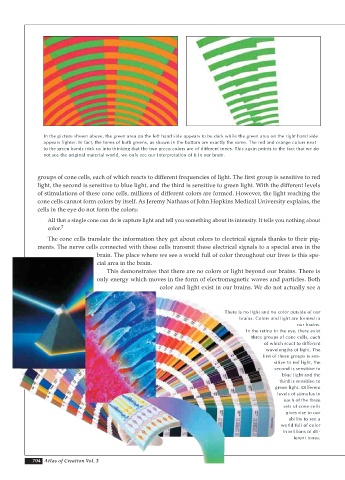Page 706 - Atlas of Creation Volume 3
P. 706
In the picture shown above, the green area on the left hand side appears to be dark while the green area on the right hand side
appears lighter. In fact, the tones of both greens, as shown in the bottom are exactly the same. The red and orange colors next
to the green bands trick us into thinking that the two green colors are of different tones. This again points to the fact that we do
not see the original material world, we only see our interpretation of it in our brain.
groups of cone cells, each of which reacts to different frequencies of light. The first group is sensitive to red
light, the second is sensitive to blue light, and the third is sensitive to green light. With the different levels
of stimulations of these cone cells, millions of different colors are formed. However, the light reaching the
cone cells cannot form colors by itself. As Jeremy Nathans of John Hopkins Medical University explains, the
cells in the eye do not form the colors:
All that a single cone can do is capture light and tell you something about its intensity. It tells you nothing about
color. 7
The cone cells translate the information they get about colors to electrical signals thanks to their pig-
ments. The nerve cells connected with these cells transmit these electrical signals to a special area in the
brain. The place where we see a world full of color throughout our lives is this spe-
cial area in the brain.
This demonstrates that there are no colors or light beyond our brains. There is
only energy which moves in the form of electromagnetic waves and particles. Both
color and light exist in our brains. We do not actually see a
There is no light and no color outside of our
brains. Colors and light are formed in
our brains.
In the retina in the eye, there exist
three groups of cone cells, each
of which react to different
wavelengths of light. The
first of these groups is sen-
sitive to red light, the
second is sensitive to
blue light and the
third is sensitive to
green light. Different
levels of stimulus to
each of the three
sets of cone cells
gives rise to our
ability to see a
world full of color
in millions of dif-
ferent tones.
704 Atlas of Creation Vol. 3

